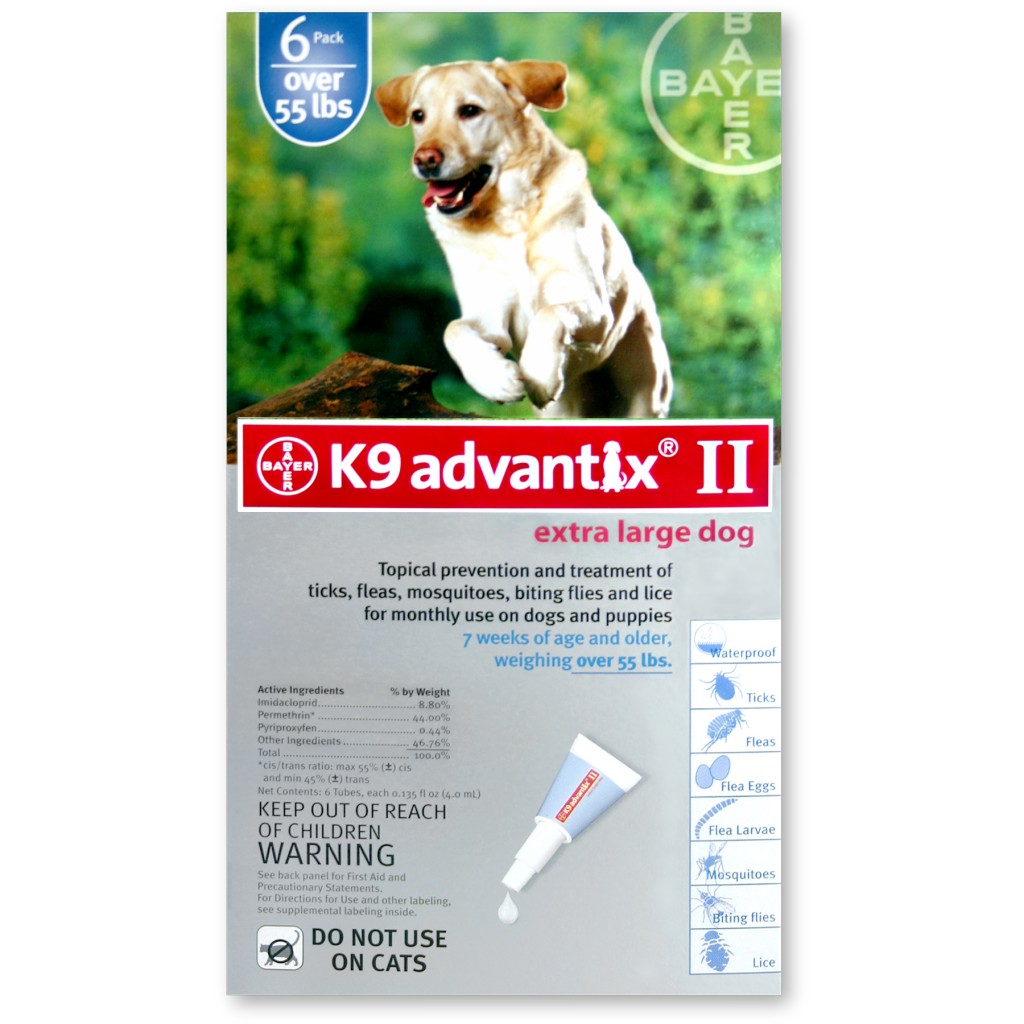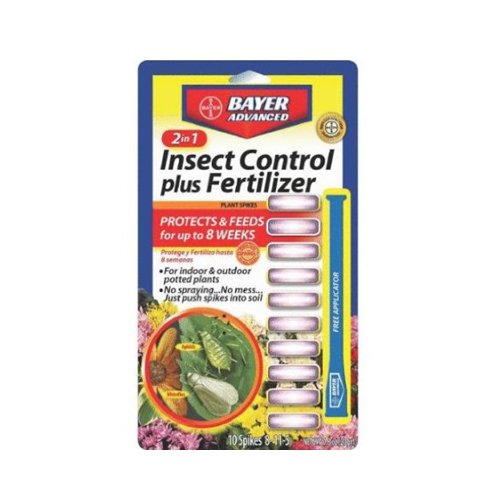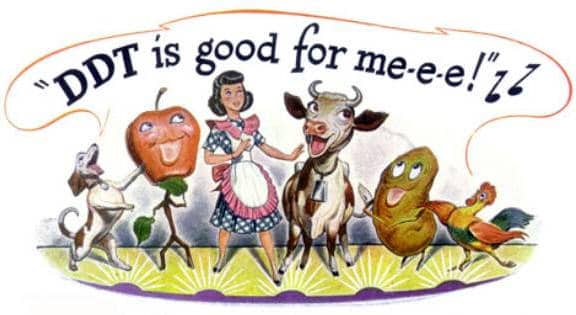DDT advertisement circa 1947 from Pennsalt Chemicals.
In a recent article for the American Bee Journal, Ron Phipps writes:
[…] it is becoming increasingly clear that the widespread use of neonicotinoids on agricultural crops is a major factor [for annual honeybee losses.] The manufacturers of these pesticides, like the manufacturers of tobacco products in an earlier era, are masters at obfuscation and denial of the harmful effects of the products from which they derive huge profits.—Ron Phipps, “International Honey Market,” American Bee Journal (July 2014)
In the same article, the author points out that the widely quoted figure that honeybees are responsible for a third of our food is true only in total agricultural production. In fact, honeybees are responsible for a much higher percentage of the nutrient-rich “…phyto-chemical foods, including almonds, oranges, apples, blueberries, cranberries, etc., which are at stake. The health of bees is inextricably integrated with the health of humanity.” Well said, Ron!
Even so, the EPA and the USDA still say that Colony Collapse Disorder (CCD) is a serious problem with no known cause.
As the authors of a document titled Report on the National Stakeholders Conference on Honey Bee Health (October of 2012) state: “a complex set of stressors and pathogens is associated with CCD, and researchers are increasingly using multi-factorial approaches to studying causes of colony losses.”
They go on to claim that the following issues contribute to CCD:
- Parasitic mite Varroa destructor
- Viruses
- Bacterial diseases, including European foulbrood
- Nutritional deficiencies
- Gut microbe imbalances
- Acute and sub-lethal effects of poisons
These issues are a smokescreen intended to distract the public from the root cause of colony loss—poison. More specifically, systemic poison. This is the one cause that directly contributes to all of the other alleged causes. Yet it’s also the one that is systematically avoided by the EPA, whether by failing to require adequate field trials before registration (as in clothianidan), or by failing entirely to test water and soil residue levels.
Because of the EPA’s avoidance of the issue, non-government organizations (NGOs) must raise money and perform tests independently. In 2013, one such NGO did just that. Friends of the Earth produced their first Gardeners Beware report, which revealed that systemic poisons are commonly found in bee-attractive plants sold in home gardening centers. In 2014, their findings were confirmed in a new and expanded Gardeners Beware with the same results. Flowering plants were tested in 18 locations in the U.S. and Canada. Flower parts were tested separately from greenery. Systemic poisons, in this case a class of neuro-active insecticides known as neonicotinoids, were found in 51 percent of the nursery plants, some at levels toxic to honeybees and other pollinators. Unless specifically referenced otherwise, the remainder of this article will focus exclusively on data from the 2014 Gardeners Beware report, which provides excellent condensed coverage of the issues behind our widespread pollinator declines.
Systemic poisons are so-called because they become part of the exposed plant itself—every part, including nectar, pollen, and whatever fruit or vegetable it produces. The exposure may be as small as parts per billion, but every part of the plant will carry the poison. Even at pre-lethal doses, these have been shown to damage the honeybee immune system and impair fertility, learning, and forage capabilities. And due to the complete, irreversible blockage of the post-synaptic nicotinic acetycoline receptors (nAChRs) these poisons renders the honeybee more vulnerable to parasites, viruses, and bacteria. It also damages the normal gut microbes that would otherwise aid the honeybee’s immune response.
By the way, birds and mammals also have nAChRs. When these animals are exposed to systemic poison, their receptors become irreversibly blocked as well.

Of the samples that tested positive for neonicotinoids, about half contained poison, either evenly distributed across flowers and greenery, or concentrated in the flowers alone. This suggests that pollinators may actually be more vulnerable to systemics than target insects such as grubs.
Bayer, Syngenta, and others have convinced farmers that they need these poisons to increase their yields, but what if that isn’t true? After the Center for Food Safety reviewed 19 scientific journal articles about the relationship between neonicotinoid-treated crops and resulting yields, they found that “toxic insecticides are being unnecessarily applied in most cases.”
But farmers aren’t alone when it comes to the use of systemic poisons. The general public also uses systemics in their backyard gardens, though they may not know it. Some brands of potting soil offered to consumers have been pretreated with systemic poison—and these may or may not be labeled with the active ingredient. So even if you do read the labels on all your garden center purchases, it’s still possible to bring systemic poison back home to your yard and family without your knowledge.
And, according to Gardeners Beware, “Many of the seedlings and plants sold in nurseries and garden stores across the U.S. are being treated with neonicotinoids at much higher doses than are used on farms.” You read that right. Consumer garden products that contain systemic poisons contain them at higher concentrations than those meant for farmers. For example, when used according to label on perennials, the imidacloprid dosage is 444 times the dosage for field corn. And repeated use is allowed.
These poisons are water-soluble, which means that residue not absorbed by the plant migrates through the watershed. The potency of these poisons remains very high for long periods. For example, clothianidan can have a half-life of 1,155 days—that’s more than three years to metabolize half of the applied poison and 15.8 years to metabolize 95 percent of the applied poison. How many of us ever stop to think that the poison we apply today may still affect our habitats 15 years from now?

The sad fact is that long-life poisons have become part of our landscape. Any plant placed in systemic- contaminated soil readily absorbs the poison and becomes a player. One important question is this: Does the poison actually make it to the flower? The Gardeners Beware report analyzed 71 samples, which were gathered in this manner:
Materials from multiple potted plants of the same kind were combined in bags for flowers or greenery to provide sufficient material for the analysis of a single sample. As a result, 190 individual plants were analyzed as part of 71 whole plant samples (divided into flower and stems & leaves sub-samples) submitted for analysis.
Now here’s some detail about the results. Notice the big, hard-to-pronounce words. I bet you skip over most of them—and that’s not an accident. The chemical industry doesn’t want you to talk about these products. It’s hard to make a convincing argument against something when you can’t even pronounce it without sounding like an idiot. That’s their strategy and it’s very effective. The big players like Bayer, Syngenta, Dow, Dupont, and BASF are awesome at sales and marketing.

The [independent] analytical lab detected the following pesticides and breakdown products in these plant samples: acetamiprid, clothianidin, clothianidin TZMU (lower toxicity degradate), dinotefuran, flonicamid, imidacloprid, 5-hydroxy imidacloprid (toxic degradate), imidacloprid des nitro (lower toxicity degradate), imidacloprid olefin (toxic degradate), imidacloprid olefin des nitro (lower toxicity degradate) and thiamethoxam.
Worldwide, imidacloprid is the most widely used poison today. So it’s not surprising that it’s also the most frequently detected poison in the Gardeners Beware study:
Imidacloprid and its metabolites [the substances left when a chemical breaks down] were found most frequently, with residues of the parent imidacloprid detected in 28 of the 36 (77 percent) plant samples that tested positive for neonicotinoids.
Sixty percent of the neonicotinoid-positive samples showed only one neonicotinoid and its metabolites, while 40 percent showed multiple neonicotinoids. Since these are almost never applied using multiple chemicals in a single application, this implies that the plants are subjected to multiple applications in the short amount of time before they arrive to the consumer. Toxicity levels in flower samples were similar to the levels found in stems and leaves.
Gardeners Beware gathers so much more than just primary study results. The report also contains a comprehensive review of the many stressors affecting pollinators today, and offers insight about the manufacturers’ response. If you really want to understand why we’re losing our pollinators today, this report is a worthwhile read.
What can you do? Garden organically of course. Also, find nurseries that raise their own plants organically and sell organically-sourced plants. When you have to buy the commercial plants, discard as much of the soil as is safe for the root system into a bag, and throw it out. Replace it with your own organic soil. Naturally, raise everything you can yourself. The Flower Farmer is a great reference and will get you started.
Building up the soil’s immunity is key to detoxifying it. So use an abundance of organic matter, rock dust minerals, microryza, earthworms, and beneficial bacteria. Over time, the living systems in soil will overthrow the poisons.



Wow, this is a great clear view of the secret invasion of our yards, gardens and homes of the big neurotoxic pesticides, neonocitinoids. Well done, Don Studinski!!